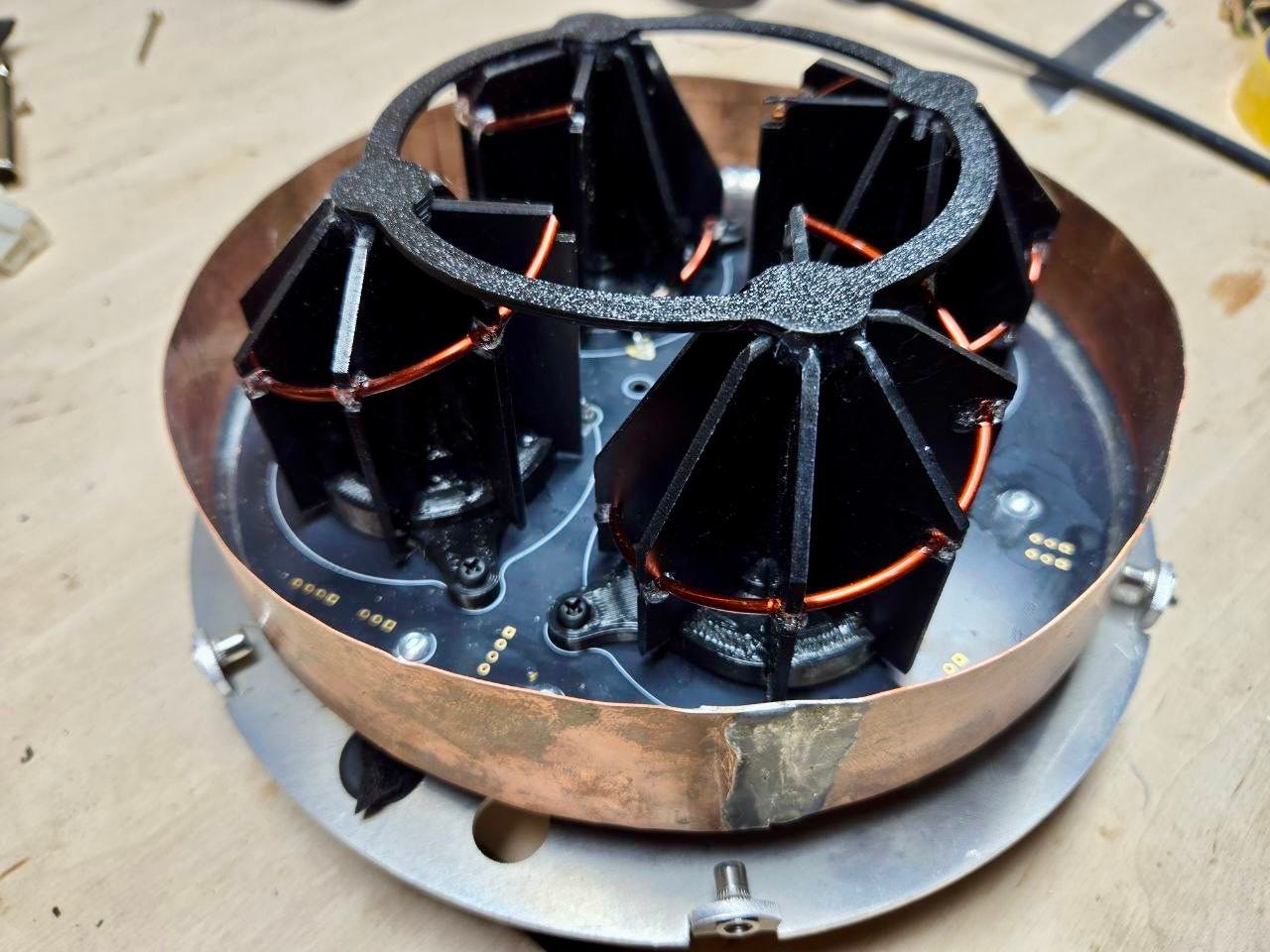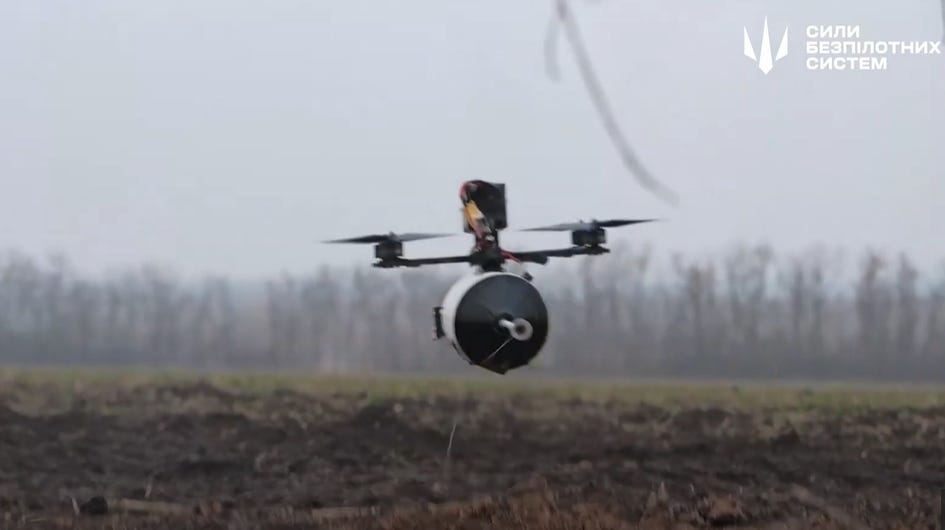Radio Jamming Will Not Protect You From the Next Drone Attack
Consumer drones land when jammed. Military drones don't.
At Soundryx, we are obsessed about one problem:
Our enemies want to use small drone aircraft to kill us.
We sell a network of sensors that allow you to detect an enemy drone, but you still need a way to disable enemy drones.
So we are writing a series of essays to examine the various ways to disable a drone.
In this essay, we’ll examine how to disable a drone’s ability to navigate by jamming the radio signals it relies upon to navigate. We’ll discuss:
how radio jamming works to disrupt consumer drones.
why jamming is no longer an effective method of protection against military drones.
What is a radio jammer?
A radio jammer emits intense radio waves on specific frequencies—with the intent of drowning out the ability of others to communicate on those radio frequencies.
A jammer can be installed at a fixed location, or it can be inside of a handheld weapon that a soldier or police officer aims at an incoming drone.
For example, DroneGun Tactical is a handheld drone jamming weapon invented by the Australian defense firm DroneShield.

Jamming is effective at stopping (mostly consumer) drones, without the risks of actually shooting at the drone with a real gun or a rocket.
Where is drone jamming employed?
On the battlefield. Radio jamming is employed by every modern military in the world—both against drones and other radio devices. Both Russia and Ukraine heavily employ radio jamming against each other’s drones. Jamming protects soldiers from drone attacks, and can also be used to jam the enemy’s defending drones when launching attacks.
Executive protection. Jamming is used to prevent drones from assassinating high-profile figures. In 2023, during the inauguration of Brazilian President Luiz Inácio Lula da Silva, Brazilian police used a DroneGun Tactical to neutralize four suspicious drones that were heading towards the President.
Protecting large events. Police have used jamming to neutralize drones that threatened a soccer game in Wuhan, China, the 2018 Commonwealth Games in Australia, and other sporting events around the world.
The collateral damage of jamming
But even when jamming is effective, it does come with a few downsides. If you use a jammer against drones, you might1 also disrupt nearby benevolent uses of radio communication, like:
civilian cell phone and GPS usage.
military and police radio communications.
communication and navigation for your own drones, helicopters, planes, etc2.
Because of this, the use of radio jamming equipment is tightly regulated by most governments in the industrialized world.
The legality of jamming
In the United States, radio jammers are more-or-less banned by federal law3. However, the law grants exceptions4 to the Departments of Defense, Energy, Homeland Security, and Justice to use jamming against enemy drones5.
As of this essay’s publication (May 2025), local and state agencies in the United States cannot engage in drone jamming unless under the direction of the DoD, DoE, DHS, or DOJ. There has been legislation proposed to change this, but they have not become law as of this time of writing.
How jamming affects consumer drones
A typical drone receives6 radio signals from both:
their controller (usually operated by a human drone pilot) that tells them where to fly
satellite positioning networks like GPS or GLONASS that tells the drone where it is on Earth.
If we want to use radio jamming to stop an enemy drone, we can try to interrupt either the control link, the satellite link, or both.
If we jam a consumer drone (like a DJI Mavic), then it will either7:
hover in place, waiting to regain its radio link.
descend and land, waiting for the drone pilot to come find it.
fly back to the “home” location where the drone began its current flight.
Consumer drones are programmed with the above behaviors to make it easier for the drone pilot to retrieve their drone if it flies out of the controller’s radio range.
But these pre-programmed behaviors also allow militaries and law enforcement agencies to jam a hostile consumer drone—preventing it from trespassing further into restricted airspace, and possibly even following the drone back to its pilot.
How military drones resist jamming
Some militaries or armed groups will use off-the-shelf consumer drones like the DJI Mavic. These drones are cheap (by military standards) and highly effective against enemies that do not defend themselves with radio jamming or other methods of electronic warfare.
But many military drones are designed to be resistant to radio jamming, using one or more of the following strategies:
1. Jamming-resistant radio antennas
Many military drones use frequency hopping8 or beamforming9 so that their radio communications can punch through their enemy’s jamming efforts.
For example, the below image features a Ukrainian drone’s beamforming antenna array for satellite navigation. The array is made up of four antennas, which allow the drone to listen to satellite communications from above while ignoring radio jamming from below.

2. Radio-free navigation
Many drones can follow a pre-programmed flight path without needing a radio link to a controller. They can also use inertial sensors or computer vision to navigate without a radio link to satellite navigation.
A reconnaissance drone can be programmed to fly home in the face of jamming.
A kamikaze drone can be programmed to continue to fly to its target despite jamming.
Some drones have a relatively simple method of radio-free navigation. For example, Russia’s Lancet drones fly autonomously once they lock onto their target.
Other drones autonomously navigate using artificial intelligence and sensors—like cameras or LIDAR.
There are numerous types of drones capable of this feat, but perhaps the most iconic drone of its type was created at the Defense Tech Hackathon in El Segundo in February 2024.
The contestants at the hackathon went on to create a company around the drone, went through Y Combinator, and raised $4.3 million.

3. Attacking the jammer
If you are operating a radio jammer10, you are emitting a trail of powerful radio waves that reveal your position. An enemy’s weapon follow this trail, find you, and kill you.
The term anti-radiation (as in, anti-radio) refers to bombs, missiles, drones, and loitering munitions that can home in on an enemy radio emission—whether it is a RADAR, a jammer, or a communication radio.
4. Fiber-optic cables
A fiber-optic drone does not use radio to communicate at all. Instead, each drone carries a spool of fiber-optic cable—up to 20 kilometers long—that provides a wired connection directly to the drone’s controller11.
Fiber-optic drones were first deployed by the Russians against the Ukrainians in early 2024, with the Ukrainians following suit soon after.

The upside: Because these drones do not need to emit radio signals, they are impossible to jam via radio. It is also impossible to detect these drones by listening for any radio waves they emit, because they don’t emit any. This is different than RADAR, where you emit a radio wave that bounces off of the drone.
The downside: The fiber-optic cables can be fragile. They can break or get tangled in trees. The cables can also only be used once, which makes them not useful for drones that are supposed to fly more than once.
Conclusion
At Soundryx, we have two predictions about the future of drone jamming in the year 2025 and beyond:
1. Jamming will continue to be effective against consumer drones
Consumer drones will always be designed to stop or fly home when they lose their radio link.
Jamming is the ideal weapon for police departments to use against consumer drones, but laws in the US and elsewhere must change to allow police departments to employ jamming.
2. Jamming will become worthless against drones on the battlefield
In the past and present, jamming has been highly effective against drones on the battlefield. Both Russia and Ukraine have heavily employed jamming and other electronic warfare (EW) techniques against each other’s drones.
But looking beyond 2025, we expect that military drones will lose their dependence on radio and become immune to jamming.
Further reading
We have written about several other methods for disabling enemy drones.
Whether a drone radio jammer would harm benevolent radio communications depends on whether the drone (and thus the jammer targeting it) are broadcasting on the same frequencies as the benevolent radio communications. But it is reasonable to assume that an enemy drone would want to use the same frequencies as our benevolent communications—specifically so that we have to harm our own communications when jamming the enemy.
Anti-drone systems can affect air traffic control in unexpected ways. Earlier this year, the US Secret Service faced scrutiny for testing an anti-drone technology at a Department of Defense facility near Ronald Reagan Airport outside of Washington DC. I don’t know if this technology was a jammer or something else, but it operated on a radio frequency that overlapped with the airport’s Traffic Collision Avoidance System (TCAS). The radio interference caused the TCAS to issue multiple false alarms of a pending air collision—causing flight crews to unnecessarily take evasive action.
In the United States, federal law prohibits the “manufacture, importation, marketing, sale, or operation” of radio jamming equipment—whether they are intended to jam drones or other radio devices.
As of the time of this essay’s publication, these are the following legal carveouts that allow US federal agencies to engage in drone jamming:
10 U.S. Code § 130i grants a drone jamming exception to the Department of Defense.
50 U.S.C. § 2661 grants a drone jamming exception to the Department of Energy for the purpose of protecting nuclear facilities and similar missions.
6 U.S.C. § 124n grants an exception to the Departments of Justice and Homeland Security.
49 U.S.C. § 44810(c)–(d) allows the Federal Aviation Administration to test drone jammers, but not to deploy them in mission scenarios.
For those readers that are interested in the US Government’s technical and legal perspective on drone jamming, the 2019 Department of Homeland Security publication “Counter-Unmanned Aircraft Systems: Technology Guide” is worth reading.
Note that drones typically send radio signals back to the controller—whether the drones are reporting their status or sending a video stream. However, drones only receive radio signals from GPS and other navigation satellites. This makes it possible to jam a drone’s ability to use satellite navigation, but not to passively listen to a drone using satellite navigation.
When a drone is being jammed, which action it takes depends on several factors:
A drone cannot automatically fly home if its satellite navigation is being jammed—unless it can navigate home with inertial sensors or other means.
Many drones allow the pilot to select the drone’s default behavior when it loses its radio link to the controller, satellite navigation, or both. For DJI drones, their documentation describes how return-to-home behavior works for typical cases like low battery. For Skydio drones, their documentation describes how to program return behaviors and locations.
Frequency hopping is a technique where two devices communicating over radio continually change the radio frequency that they use to communicate with each other. Both devices know the pseudorandom sequence of frequencies that they’ll both switch to at the same time. In order for a jammer to continually disrupt communication between these two devices, the jammer would have to follow the frequency hops—which is not an easy task if the jammer does not know the “pseudorandom sequence” of frequencies that the devices know.
Beamforming is a method of designing arrays of sensors—whether they are radio antennas, microphones, or another sensor—and processing the data from those arrays to increase signal reception. Amazon Alexa devices use beamforming microphone arrays to hear voices from across a large room.
Note that we have the same problem if, instead of a jammer, we are using an active RADAR sensor to detect incoming drones. The RADAR sensor emits powerful radio waves, which reveal your position—which is problematic if you wanted to hide from incoming drones.
The idea of tethered aircraft has been around for some time. Raytheon invented the MGM-157 Enhanced Fiber Optic Guided Missile (EFOGM) in the 1980s.


